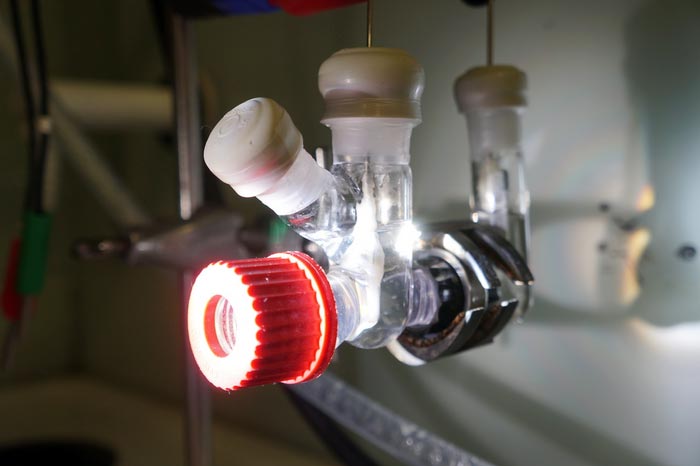Solar-powered system converts plastic and greenhouse gases into sustainable fuels

Researchers have developed a system that can transform plastic waste and greenhouse gases into sustainable fuels and other valuable products – using just the energy from the Sun.
Credit: University of Cambridge
Researchers have developed a system that can transform plastic waste and greenhouse gases into sustainable fuels and other valuable products – using just the energy from the Sun.
The researchers, from the University of Cambridge, developed the system, which can convert two waste streams into two chemical products at the same time – the first time this has been achieved in a solar-powered reactor.
The reactor converts the carbon dioxide (CO2) and plastics into different products that are useful in a range of industries. In tests, CO2 was converted into syngas, a key building block for sustainable liquid fuels, and plastic bottles were converted into glycolic acid, which is widely used in the cosmetics industry. The system can easily be tuned to produce different products by changing the type of catalyst used in the reactor.
Converting plastics and greenhouse gases – two of the biggest threats facing the natural world – into useful and valuable products using solar energy is an important step in the transition to a more sustainable, circular economy. The results are reported in the journal Nature Synthesis.
“Converting waste into something useful using solar energy is a major goal of our research,” said Professor Erwin Reisner from the Yusuf Hamied Department of Chemistry, the paper’s senior author. “Plastic pollution is a huge problem worldwide, and often, many of the plastics we throw into recycling bins are incinerated or end up in landfill.”
Reisner also leads the Cambridge Circular Plastics Centre (CirPlas), which aims to eliminate plastic waste by combining blue-sky thinking with practical measures.
Other solar-powered ‘recycling’ technologies hold promise for addressing plastic pollution and for reducing the amount of greenhouse gases in the atmosphere, but to date, they have not been combined in a single process.
“A solar-driven technology that could help to address plastic pollution and greenhouse gases at the same time could be a game-changer in the development of a circular economy,” said Subhajit Bhattacharjee, the paper’s co-first author.
“We also need something that’s tuneable, so that you can easily make changes depending on the final product you want,” said co-first author Dr Motiar Rahaman.
The researchers developed an integrated reactor with two separate compartments: one for plastic, and one for greenhouse gases. The reactor uses a light absorber based on perovskite – a promising alternative to silicon for next-generation solar cells.
The team designed different catalysts, which were integrated into the light absorber. By changing the catalyst, the researchers could then change the end product. Tests of the reactor under normal temperature and pressure conditions showed that the reactor could efficiently convert PET plastic bottles and CO2 into different carbon-based fuels such as CO, syngas or formate, in addition to glycolic acid. The Cambridge-developed reactor produced these products at a rate that is also much higher than conventional photocatalytic CO2 reduction processes.
“Generally, CO2 conversion requires a lot of energy, but with our system, basically you just shine a light at it, and it starts converting harmful products into something useful and sustainable,” said Rahaman. “Prior to this system, we didn’t have anything that could make high-value products selectively and efficiently.”
“What’s so special about this system is the versatility and tuneability – we’re making fairly simple carbon-based molecules right now, but in future, we could be able to tune the system to make far more complex products, just by changing the catalyst,” said Bhattacharjee.
Reisner recently received new funding from the European Research Council to help the development of their solar-powered reactor. Over the next five years, they hope to further develop the reactor to produce more complex molecules. The researchers say that similar techniques could someday be used to develop an entirely solar-powered recycling plant.
“Developing a circular economy, where we make useful things from waste instead of throwing it into landfill, is vital if we’re going to meaningfully address the climate crisis and protect the natural world,” said Reisner. “And powering these solutions using the Sun means that we’re doing it cleanly and sustainably.”
The research was supported in part by the European Union, the European Research Council, the Cambridge Trust, Hermann and Marianne Straniak Stiftung, and the Engineering and Physical Sciences Research Council (EPSRC), part of UK Research and Innovation (UKRI). Erwin Reisner is a Fellow of St John’s College, Cambridge.
Journal: Nature Synthesis
DOI: 10.1038/s44160-022-00196-0
Article Title: Photoelectrochemical CO2-to-fuel conversion with simultaneous plastic reforming
Article Publication Date: 9-Jan-2023
Media Contact
Sarah Collins
University of Cambridge
sarah.collins@admin.cam.ac.uk
Office: 01223765542
Cell: 7525337458
All latest news from the category: Power and Electrical Engineering
This topic covers issues related to energy generation, conversion, transportation and consumption and how the industry is addressing the challenge of energy efficiency in general.
innovations-report provides in-depth and informative reports and articles on subjects ranging from wind energy, fuel cell technology, solar energy, geothermal energy, petroleum, gas, nuclear engineering, alternative energy and energy efficiency to fusion, hydrogen and superconductor technologies.
Newest articles

Innovative 3D printed scaffolds offer new hope for bone healing
Researchers at the Institute for Bioengineering of Catalonia have developed novel 3D printed PLA-CaP scaffolds that promote blood vessel formation, ensuring better healing and regeneration of bone tissue. Bone is…

The surprising role of gut infection in Alzheimer’s disease
ASU- and Banner Alzheimer’s Institute-led study implicates link between a common virus and the disease, which travels from the gut to the brain and may be a target for antiviral…

Molecular gardening: New enzymes discovered for protein modification pruning
How deubiquitinases USP53 and USP54 cleave long polyubiquitin chains and how the former is linked to liver disease in children. Deubiquitinases (DUBs) are enzymes used by cells to trim protein…



